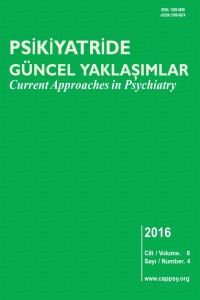Glutamat Sistemi ve Şizofreni
Abstract
Glutamat santral sinir sisteminin ana uyarıcı nörotransmitteridir. Glutamat öğrenme, bellek ve algı gibi birçok bilişsel fonksiyonlarda görev alır. Glutamat beyin gelişiminde, nöronal göçte, nöronal farklılaşmada, akson oluşumunda ve nöronal yaşamında önemli görev almaktadır. Glutamat birçok nörodejeneratif hastalıkta görülen eksitotoksisite ile ilişkilendirilmektedir. Şizofreni patogenezinde glutamat disfonksiyonun katkısı olduğunu düşündüren birçok kanıt bulunmaktadır. Fensiklidin ve ketamin gibi NMDA reseptör antagonistleri sağlıklı gönüllülerde hem pozitif hem de negatif belirtilere neden olabilmektedir. Ayrıca bu moleküller şizofreni hastalarında belirtileri arttırmaktadır. Bu nedenle şizofreninin N-metil-D-aspartat (NMDA) reseptör hipofonksiyonu ile ilişkili olduğu öne sürülmüştür. Bu hipoteze göre NMDA reseptör hipofonksiyonu glutamat nöronları üzerindeki inhibisyonun azalmasına ve aşırı glutamat salınımına yol açmaktadır. Sonuçta, şizofreni hastalarında birçok beyin bölgesinde görülen hacim azalmasının NMDA reseptör aracılı glutamat nörotoksisitesi ile ilişkili olduğu düşünülmektedir.
Glutamatergic System and Schizophrenia
Abstract
Glutamate is the major excitatory neurotransmitter in the brain. It has a role several cognitive func-tions including learning, memory and perception. Glutamatergic neurotransmission is also involved in regulating neuronal migration, synaptogenesis, and the pruning neurons. Glutamatergic exci-totoxicity has been implicated in various neuropsychiatric disorders. Accumulating evidence suggests that glutamatergic dysfunction may contribute to the pathogenesis of schizophrenia. The N-methyl-D-aspartic acid (NMDA) receptor antagonists such as phencyclidine and ketamine can cause both the positive and negative symptoms psychotic symptoms in normal humans, and worsen these symptoms in persons with schizophrenia. Hence, it has been hypotesized that schizophrenia may be associated with decreased NMDA-receptor activity. According to the hypothesis, NMDA reseptor hypofunction can lead to decreased inhibition of glutamatergic neurons and excessive glutamate release. Finally, the reduction of gray matter in several brain regions seen in patients with schizophrenia has been suggested to be the result of neurotoxicity mediated by NMDA receptors.
Details
| Subjects | Health Care Administration |
|---|---|
| Journal Section | Review |
| Authors | |
| Publication Date | December 31, 2016 |
| Acceptance Date | May 31, 2016 |
| Published in Issue | Year 2016 Volume: 8 Issue: 4 |
Cited By
Şizofreni: Etyoloji, Klinik Özellikler ve Tedavi
Arşiv Kaynak Tarama Dergisi
Gonca Karakuş
https://doi.org/10.17827/aktd.303574
Aşırı Yeşil Çay Tüketimi İle İlişkili Mani: Bir Olgu Sunumu
Anadolu Kliniği Tıp Bilimleri Dergisi
https://doi.org/10.21673/anadoluklin.1039944
Etiopathogenesis of depression and experimental depression models used in preclinical studies
European Journal of Life Sciences
https://doi.org/10.55971/EJLS.1327521
|
 Psikiyatride Güncel Yaklaşımlar - Current Approaches in Psychiatry is licensed under a Creative Commons Attribution-NonCommercial-NoDerivatives 4.0 International License. |

